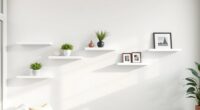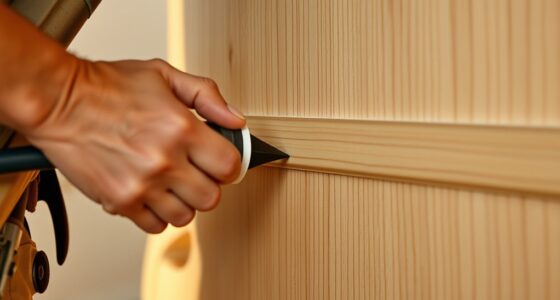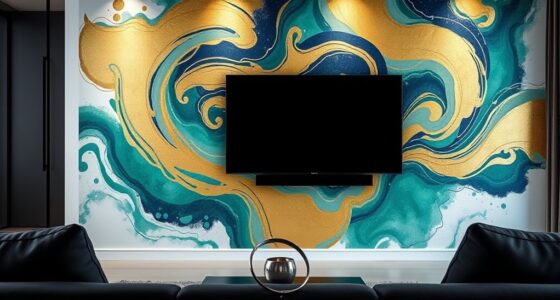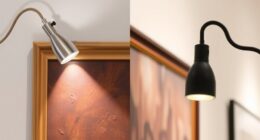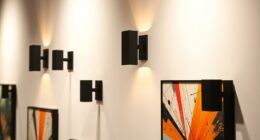When removing wall texture, wet scraping softens surfaces with water, making it quicker for thick or popcorn textures, but it can be messy and requires safety precautions. Skim coating applies a thin joint compound layer for a smooth finish, taking more time but producing a cleaner look. Your choice depends on how thick or uneven the texture is and the desired outcome. Keep exploring to find the best method and tools for your project.
Key Takeaways
- Wet scraping softens and removes thick or textured surfaces quickly but is messier and generates debris.
- Skim coating creates a smooth finish by applying a thin layer of joint compound, suitable for uneven or thin textures.
- Wet scraping requires tools like putty knives and proper safety gear, while skim coating uses wide trowels or putty knives.
- Wet scraping is faster for heavy textures; skim coating provides a seamless surface but takes more time and skill.
- Choosing between methods depends on texture thickness, desired finish, and available time and tools.
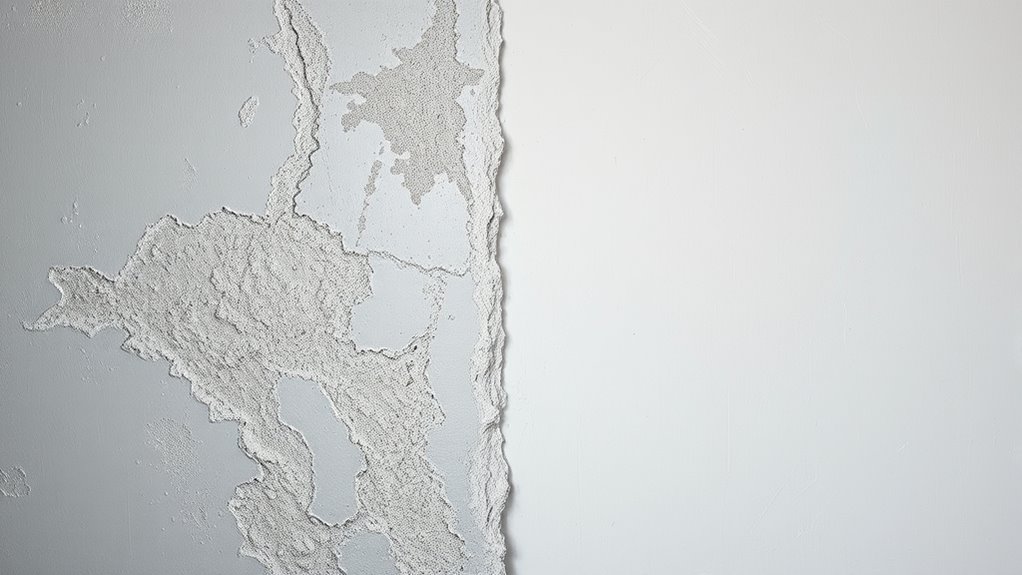
Removing Texture
Have you ever wished you could smooth out a rough wall or surface? Removing texture can be a challenging task, but understanding your options helps you choose the best approach. When it comes to removing texture, two popular methods stand out: wet scraping and skim coating. Each has its own advantages and considerations, especially regarding tool alternatives and safety precautions. Knowing which method suits your project can make a significant difference in the final result and your experience during the process.
Wet scraping involves spraying water onto the textured surface to soften the material, making it easier to remove. This method is especially effective for popcorn or thick textures. You’ll need tools like putty knives, scrapers, or even a drywall taping knife, but there are tool alternatives that can also work well. For instance, a flat drywall sander with a vacuum attachment can help reduce dust and speed up the process. It’s important to wear safety precautions, such as goggles and a dust mask, because scraping can generate debris and dust particles that irritate your eyes and lungs. If you’re concerned about the mess, cover nearby furniture and floors with plastic sheeting to contain any splatters or dust. Always test a small section first to see how easily the texture softens with water, and proceed gradually to avoid damaging the drywall underneath. Using appropriate safety equipment can further reduce health risks during the process.
Spray water on textured surfaces, wear safety gear, and protect surroundings for effective wet scraping.
On the other hand, skim coating involves applying a thin layer of joint compound over the textured surface to create a smooth finish. This technique is often used when the texture is too thick or uneven for scraping. For tool alternatives, you might consider using a putty knife or a wide drywall trowel to spread the compound evenly. Safety precautions here include ensuring proper ventilation, especially when sanding the dried skim coat, which can produce fine dust. Wearing a mask and goggles is essential, and you should also work in well-ventilated areas to avoid inhaling dust particles. Unlike wet scraping, skim coating doesn’t involve water, so it’s less messy but requires patience and skill to achieve a seamless surface. You’ll need to sand the dried compound carefully to ensure smoothness, and again, safety gear is critical during this step.
Both methods demand attention to safety precautions, particularly regarding dust and debris. Using tool alternatives can make your job easier and safer, especially if you’re working in a tight space or want to minimize cleanup. Whether you choose water-based removal or skim coating, understanding your options and taking proper safety measures ensures you’ll achieve a professional-looking result without putting yourself at unnecessary risk. Remember, patience and preparation are key to successfully removing texture and creating a beautifully smooth surface.
Frequently Asked Questions
Can I Remove Texture Without Professional Help?
Yes, you can do a DIY removal of textured walls, but it requires proper texture prep. Start by testing a small area to see how easily it comes off, then wet scrape or use a skim coat to smooth the surface. Make sure you have the right tools and safety gear. With patience and careful work, you can successfully remove texture without professional help.
How Long Does Each Method Take to Dry?
Wet scrape typically dries within 24 to 48 hours, but the curing process can take up to a week for ideal hardness. A skim coat usually dries faster, often within 12 to 24 hours, with full curing taking about 3 to 7 days. Factors like humidity and temperature influence drying time and curing. You should guarantee proper ventilation and avoid heavy use until fully cured to prevent damage.
Will These Methods Damage the Drywall?
Removing texture is like peeling an old, cherished painting—you want to avoid damaging it. Both wet scraping and skim coating, when done properly, won’t harm your drywall’s integrity. However, aggressive scraping or improper surface preparation can cause damage, leading to cracks or gouges. Focus on gentle techniques and thorough surface prep to preserve your drywall’s strength. This way, your wall remains solid, smooth, and ready for a fresh coat of paint.
Which Method Is More Cost-Effective?
Wet scrape tends to be more cost-effective because it requires fewer materials and less labor compared to skim coating. If you’re working within a tight budget, wet scraping can save you money while effectively removing textured surfaces. However, consider your project’s specific needs, as skim coats might cost more but offer a smoother finish. Always weigh the cost comparison against your desired outcome and budget considerations before choosing a method.
Can I Apply New Texture Over the Old?
Over 60% of homeowners choose to update textures without removing old ones. You can apply new texture over existing drywall, but it’s essential to think about proper texture removal for drywall safety and achieving a smooth finish. Skim coats work well to create an even surface, while wet scrape can sometimes damage drywall if not done carefully. Always assess your current texture and condition before adding new layers to guarantee a safe, professional-looking result.
Conclusion
Removing texture is like shedding old layers to reveal your true space. Whether you choose wet scraping or a skim coat, you’re symbolically peeling away the past to create a fresh canvas. Each stroke represents a new beginning, a chance to reset and redefine your environment. Embrace the process as a journey of renewal—your home’s surface, like your life, transforms when you let go of what no longer serves you. The future is yours to shape.

